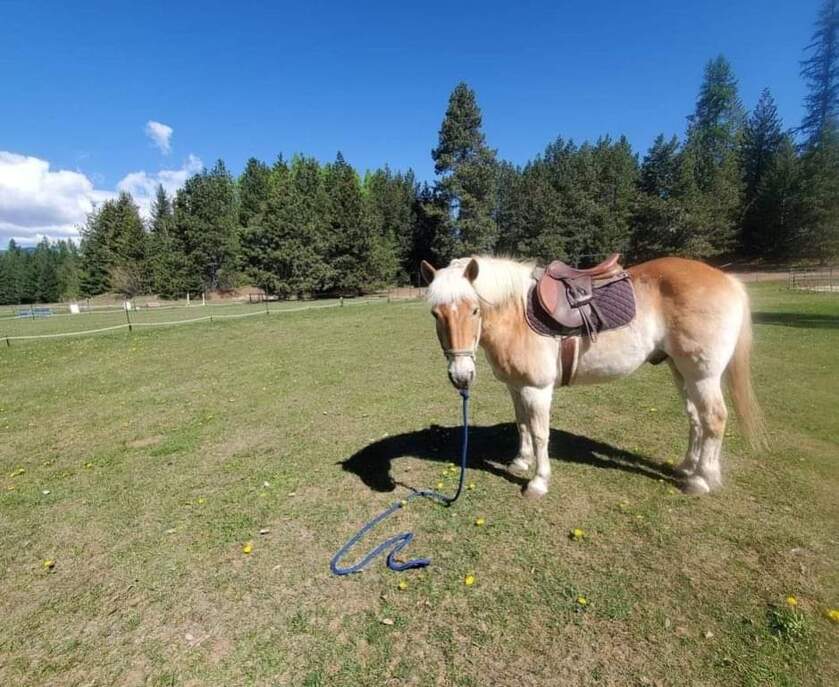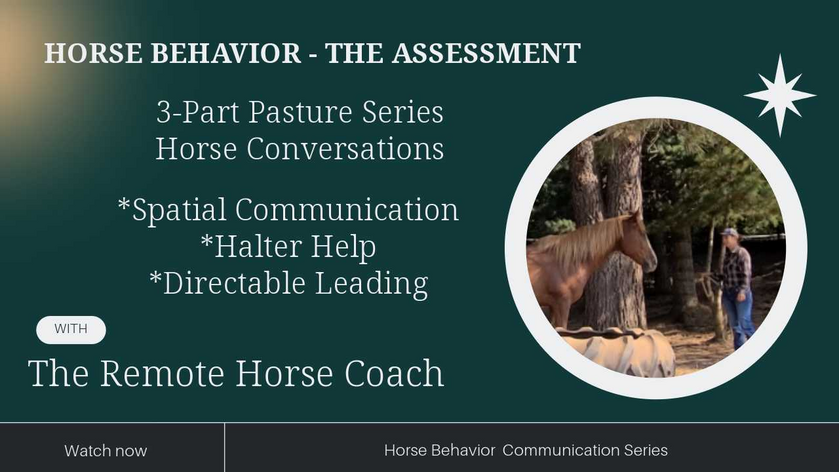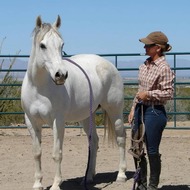
This question was posed by a student of mine and I thought it'd be a great way to start the week.
"During several of your training sessions with my horses, you reported that they were "purging." They were definitely different horses following this event. Could you explain what this is and how to tell when a horse is doing this.....and maybe why." Pam
Many horses I encounter have a level of continuous emotional containment. This creates mental stress and a physical tightness in their behavior.
So when I see horses whether alone, in a herd, with a human nearby, handled from the ground or ridden in the saddle and the movement looks disjointed I remind folks to learn how to break down the "big" picture of the general movement of the horse, into small pieces.
Starting at the head: Noticing wide or unblinking eyes, and ones that look "blank" or empty. Notice if there are peaks above the eyes. If there is a clenched jaw, a continuous diagonal of the horse's head with his nose stuck forward at an odd angle, flared or rigid nostrils, wrinkles around below or above the upper and lower muzzle area. Tightnights or rigidity in the ears and inconsistent breathing.
Neck: from directly behind the poll and jaw area is there a "swelling" or enlargement of the muscles. If you touch the length of the horse's neck does it feel rigid and long or exaggerated and shrunk up like an accordion. Is there a "U" even in non-u-necked shaped horses.
Shoulders: Is there a bulge in one or both shoulders? Can you see a separation from where the neck attaches to the shoulder or does it look like one long "piece?" As the horse moves is there an actual rotation of the shoulder or does it look tight and stiff in the movement?
Legs: Do the knees and hocks actually bend as the horse takes a step? At a halt does the horse stand balanced or with his feet point in for different directions? Does he move "leading with the hind end" first or does he move the steering end- his front legs- first? Does he stand with his legs underneath him or splayed out behind him? When he steps does it look like his body is aligned or does it look like his front and rear are walking in two different directions?
His rib cage and topline: Does it look like he is swelled up- behind the rider's leg (even without the rider on him) as if he is an inflated balloon? Does his breathing look rapid and quick even if he hasn't moved at a high rate of speed? Does the portion of his back where the saddle would sit look dropped and hollow from his whithers to his rump?
Hindquarters: Does his hip (look at the stifle too) look like it is making a full 360 deg rotation forward or does it look like it stops early? Does each side move equally?
His tail: Is it clamped down to his rump, dramatically held to one side consistent, or rigid out behind him?
This is the basic starting point of assessment. Most of these behaviors are apparent in horses that have learned to contain their response to the human.
As you start to address helping the horse let go of defensiveness, concern, stress, worry, fear, and other emotions that cause them to physically lock up their body or "brace" as I call it, you see what I call the purge. It will appear that the horse is physically "melting" in front of you as you find the area or spot (it is different in every horse and every scenario) that allows the horse to physically let go of the tension, mentally soften and emotionally let down.
I say that when you find the "right" spot of helping the horse let down, it is similar to pulling the string on a dog food bag; the string is very tight and keeps the bag sealed tight. But once you find the right way to release it, the whole thing unravels rather easily. Same thing with horses.
Often you'll see this in many forms. It could be a massive change in the physical softening of the muscles and body parts, you'll see them blowing their nose, passing manure, passing gas, sighing, chewing, jaw movement, tongue dropping out of their mouth, lowering of their overall posture, cocking of a rear foot, and most important a softness in their eye. It will appear as they have "suddenly" become present again.
It is as if they are able to release all of the containment that they often have been unintentionally taught by the human to hold on to.
Does this mean all is forever well? No. Often the familiar is offered more frequently than the actual "new" experience. So at the beginning of supporting a horse through respectful conversations, you'll experience a rollercoaster of patternized containment in the horse's processing and efforts. When you interject and help them learn to purge, this may last a minute or two, then you'll see them resort to old habits again. Part of the "training" you are offering is to help influence an alternative response from what has become a non-thoughtful, defensive reaction. Think of it as offering cognitive behavior therapy for horses.
As you refine your support, you'll start to see the horse let go of his containment faster, purge sooner, and then be able to maintain the softer mental and emotional experience for longer periods with less influence from you.
The horse then learns to trust the influence you are offering with your communication as it offers similar support he would find within a herd.
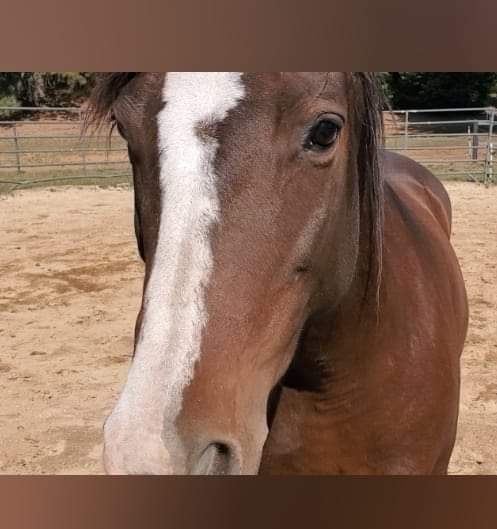
Equine Emergencies & Horse Evacuations
Please comment, like & share
Emergency Evacuation YouTube Video 1
https://youtu.be/52RflMZoP4w
Emergency Evacuation YouTube Video 2
https://youtu.be/jRCmOTq9mto
Horse Rider Communication
Common missing pieces
#alternativehorsemanship #RemoteHorseCoach #horses #horseriding #horserider #horsebackriding
*Defining & Refining Your Equine Search
*Deconstructing The Sales Ad
*Horse PreView Questions
*Learning to say "No" - 21 Common Scenarios
- 22 In-Person Tips & Tools
The must-have horse shopping guide that will help you clarify your goals, refine your search, recognize red flags, and build your confidence during your buying experience. The Remote Horse Coach shares insight from over 30 years of buying and selling horses.
"I've bought and sold many horses, and I couldn't believe how helpful this course was. Thank you!" Jillian, MI 2023
"I had ridden for years, but when it came time to purchase my first horse, the thought was daunting. I had heard plenty of horror stories and didn't want to make a mistake. I happen to find this course, and couldn't believe how it broke down the seemingly overwhelming idea of sifting through all the horse advertisements, to a plausible experience. It really worked- I finally found my horse of a lifetime. I'm forever grateful, thanks Sam!" Carolyn, MA 2023
Enroll...
Join Alternative Horsemanship™ the Remote Horse Coach as she shares unedited first session assessments of working with a 10-13 year old horse, breed unknown, past unknown. Offering voice-overs to explain how the real-time assessment occurs, what to look for in the horse's feedback, recognizing patterns, and much more.
Initial Assessment 3-part series focuses on
Spatial Awareness
Defensive Behaviors
Physical Triggers
https://remotehorsecoach.uscreen.io/orders/complete_order?o=187097
First Pasture Session - The 3-part series focuses on
Spatial Communication
Halter Help
Directable Leading
Bonus video- After the Session
https://remotehorsecoach.uscreen.io/orders/complete_order?o=187250
I often hear people talking about how it feels like they're guessing with their horse, they don't know where to start, or they don't know where/why things fall apart, creating unwanted equine behaviors.
The goal of this 2-part livestream is to help adjust the human perspective on how they observe the horse. Then to connect how their Observations can lead to developing Adaptable horse skills, to address the equine in both a real time and relevant manner.
Observation Opportunities
Sept 7th 9am pdt
Adaptable Interactions
Sept 14th 9am pdt
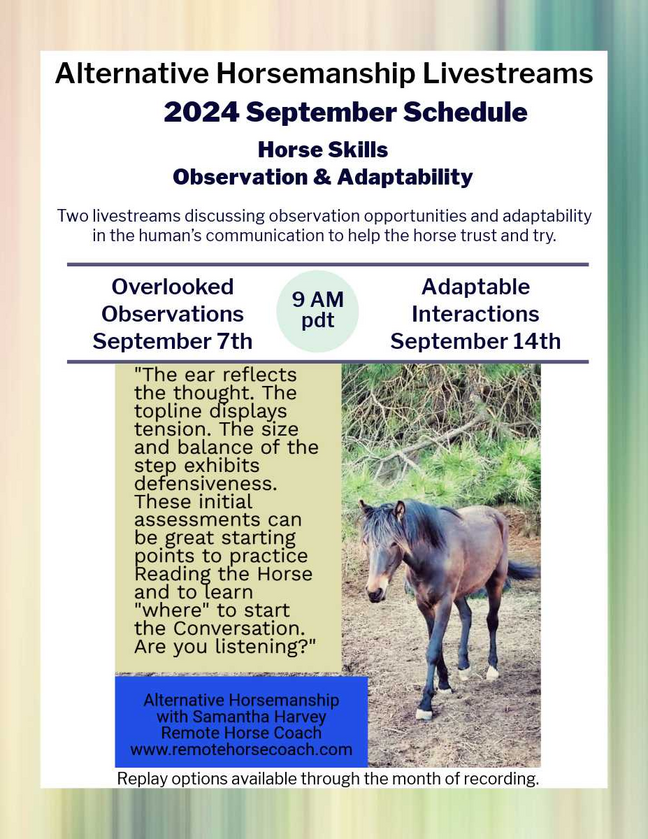
Below are some basic questions to ask in regards to your horse’s health.
I suggest keeping a horse health journal making note of diet changes, farrier care, odd behaviors, etc. It can be used as a future reference point to learn from and find what works best for the horse.
Taking pictures from both profiles, front, and rear every six months can also be a good reference.
For those who experience dramatic seasons and environmental changes and for those who have had the same horse(s) for a long time, patterns often occur out of convenience in the horse’s maintenance program.
As the horse gets older possible adjustments may need to be made to the program.
What is the general condition of your horse's mane and coat?
Weight-wise does your horse look consistent or does he look like he is carrying extra weight or pockets of fat, especially along his neck and hindquarters?
What does your horse's hoof condition look like?
Do you notice if there are changes or ridges on the outside of the hoof?
Have you taken pictures from ...
